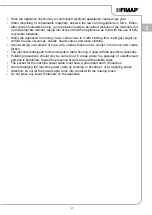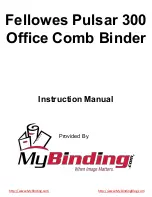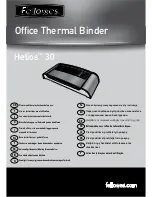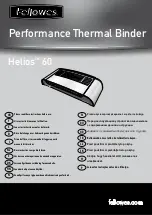
Careful cleaning of the pad holder guarantees better cleaning of the floor as well as a longer brush
motor life. To clean the pad holder, proceed as follows:
1.
Take the appliance to the dedicated dirty water drainage area.
N.B.
: the place designated for this operation must comply with current environmental protection
regulations.
2.
Check that the plug (1) on the power cable (2) has been taken out of the socket (3) of the mains
supply(
Fig.1
), and if not, disconnect it.
CAUTION:
these operations must be carried out using protective gloves to avoid any possible
contact with the edges or tips of metal objects.
ATTENTION
: To prevent damaging the power cable, disconnect the plug from the mains socket
by directly pulling the plug and not the cable.
3.
Check that the handlebar is in the vertical position, if not, press the uncoupling lever (4) (
Fig.2
)
and turn the handlebar to the vertical position (
Fig.3
). When the handlebar is vertical, release the
uncoupling lever (4).
19.2. CHECKING AND CLEANING THE PAD HOLDER
4.
Lightly tip the machine back (
Fig.4
), block one of the rear wheels and shift the control column
backwards.
5.
Turn the brush head into the vertical position (
Fig.5
).
6.
Bring the rotated brush head into contact with the floor.
7.
Remove the pad holder, and remove the impurities in it.
8.
Repeat the operations in reverse order to reassemble all the parts.
ATTENTION
: To tighten the keys correctly use a tightening clamp.
Carefully cleaning the solution tank ensures the floor is cleaned properly. Proceed as follows to clean
the solution tank:
1.
Take the device to the dedicated maintenance area.
N.B.
: the place designated for this operation must comply with current environmental protection
regulations.
2.
Check that the plug (1) on the power cable (2) has been taken out of the socket (3) of the mains
supply(
Fig.1
), and if not, disconnect it.
CAUTION:
these operations must be carried out using protective gloves to avoid any possible
contact with the edges or tips of metal objects.
ATTENTION
: To prevent damaging the power cable, disconnect the plug from the mains socket
by directly pulling the plug and not the cable.
3.
Make sure the solution tank is empty. If it isn't, empty it completely.
4.
Remove the solution tank cap (4) (
Fig.2
).
5.
Remove the water distribution pipe (5) in the hole on the brush head (6) (
Fig.3
).
19.3. CHECKING AND CLEANING THE SOLUTION TANK
6.
Disconnect the detergent solution pipe (7) from the quick coupling (8) (
Fig.4
).
CAUTION
: users are advised to always wear protective gloves, to avoid the risk of serious injury
to hands.
7.
Clean the filter under running water, if necessary remove any impurities.
8.
Remove the detergent solution pipe (7) from the hole in the solution tank (
Fig.5
).
9.
Remove the solution tank tap tie-rod chain (8) in the coupling in the tap control handle (9) (
Fig.6
).
10.
Turning the closing knob (10) (
Fig.7
) shift the top brackets beyond the stops in the tank.
11.
Remove the solution tank kit from the appliance, to lift it use the handle on the tank.
12.
Rinse the inside with a jet of water, if necessary use a spatula to remove the sludge that has
accumulated at the bottom of the tank.
ATTENTION
: Be careful not to lose the detergent solution draught filter.
13.
Put the solution tank on the column, so that the bottom of the tank is anchored to the fixed bracket
(11) on the column itself (
Fig.8
).
14.
Holding the tank with one hand, move the mobile bracket (12) down until the solution tank is locked
to the column (
Fig.9
).
15.
Lock the position of the mobile bracket (12) by tightening the closing knob (10) (
Fig.10
).
16.
Insert the water distribution pipe (5) in the hole on the brush head (6) (
Fig.11
).
17.
Insert the solution tank tap tie chain (8) in the coupling in the tap control handle (9) (
Fig.12
).
18.
Insert the detergent solution pipe (7) into the hole in the solution tank (
Fig.13
).
19.
Connect the detergent solution draught filter (7) to the quick coupling (8) (
Fig.14
). Make sure that
the draught filter stays inside the solution tank.
20.
Insert the solution tank cap (4) (
Fig.15
).
21
EN
4
5
4
5
4
2
3
1
2
3
1
1
2
3
1
6
4
5
2
3
7
8
4
8
7
9
5
6
10
7
11
8
12
9
10
10
6
5
11
9
8
12
7
13
7
8
14
4
15
19.1. RECOMMENDED MAINTENANCE OPERATIONS
19. MAINTENANCE
TYPE OF MAINTENANCE
AT THE END OF
THE WORK
WEEKL
Y
BEFORE
A LONG
PERIOD OF NON-
USE
TRANSPORT
Checking and cleaning the pad holder
X
X
X
Checking and cleaning the solution tank
X
X
X
Checking and cleaning the detergent solution spray nozzle
X
X
















































